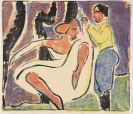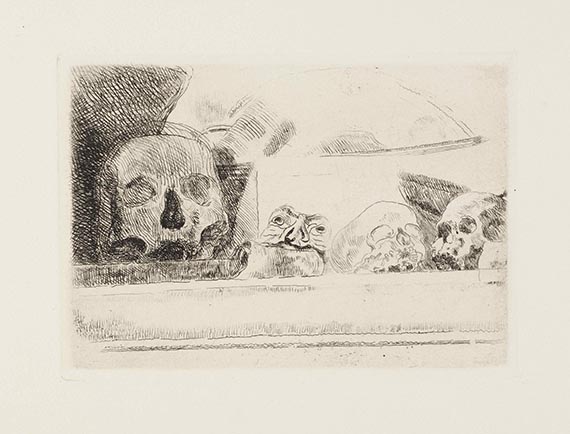
Otto Dix
1891 Gera
1969 Singen
Otto Dix is born on December 2, 1891 in Untermhaus near Gera. He does an apprenticeship as a decorator in Gera from 1905 to 1909, which is the prerequisite for his studies that he begins at the Dresden School of Applied Art in 1910. He interrupts his studies in 1914, in order to serve as a soldier in World War I to 1918, continuing his studies in Dresden as of 1919, where he finishes in 1922. Along with others Otto Dix founds the Dresden Secession – Group 1919. He is a friend of Conrad Felixmüller, and gets to know the painter George Grosz in 1920. Otto Dix participates in the First International Dada Fair in Berlin in the same year He goes to Düsseldorf in 1922 in order to join the academy as master student. He joins the circle of artists around Johanna Ey ("Mutter Ey/Mother Ey") and is member of the artist group "Das Junge Rheinland" (The Young Rhineland).
He becomes part of the Berlin Secession in 1924 and makes Berlin his hometown as of 1925, showing works at the exhibition "Neue Sachlichkeit" (New Objectivity) in Mannheim the same year. The Galerie Nierendorf contracts him in 1926, he is appointed professor at the Dresden Academy a year later.
Starting out with an expressionist style, Dix develops a more and more realistic style, leading him to a caricaturing exaggeration, depicting the ugly and cruel sides of people and everyday situations. He uninhibitedly unmasks famous people in his portraits, his very accurate style, for which Dix uses oil that he applies to wood in a manner that is similar to that of the old masters, almost seems to be a paradox. The picture’s caricature-like content is executed in flawless refinement with a great love for the detail.
The "Großstadt-Triptychon" (Metroplois Tryptich) made in 1927-28 is regarded as one of his main works – a dazzling genre picture of the 20’s with exaggerated depictions of people in screaming colors. The painting’s message is even more exaggerated by the sacral form of the triptych.
Dix faces strong hostilities from the National Socialists as of 1933 and has to stop teaching at the Dresden Academy. He is accused of sabotaging military strength, for instance with his triptych "Der Krieg" (The War) as well as of offending decency, which is why he is stigmatized as a degenerate artist. The defamations have a decisive impact on both Dix’s private life and artist career. He completely withdraws from public life and moves to Hemmenhofen on Lake Constance in 1936, turning to landscape painting and Christian and allegoric motifs. His paintings do not regain the strength they had in the 1920s.
The artist Otto Dix dies on July 25, 1969 in Siegen.
Related artists: Ackermann, Max | Ahlers-Hestermann, Friedrich | Balwé, Arnold | Bargheer, Eduard | Barlach, Ernst | Baumeister, Willi | Bechtejeff, Vladimir Georgiewitsch von | Beckmann, Max | Birkle, Albert | Bossi, Erma | Braque, Georges | Breitwieser, Georg | Buffet, Bernard | Böckstiegel, Peter August | Campendonk, Heinrich | Caspar-Filser, Maria | Cassel, Pol (Paul Ernst Karl) | Cézanne, Paul | Chagall, Marc | Corinth, Lovis | Davringhausen, Heinrich Maria | Dexel, Walter | Ehmsen, Heinrich | Ehrhardt, Curt | Erbslöh, Adolf | Feininger, Lyonel | Felixmüller, Conrad | Fleischmann, Adolf Richard | Fronius, Hans | Gauguin, Paul | Geiger, Willi | Geitlinger, Ernst | Gilles, Werner | Gotsch, Friedrich Karl | Grosz, George | Gutfreund, Otto | Hartung, Karl | Hassebrauk, Ernst | Hausmann, Raoul | Heckel, Erich | Heckendorf, Franz | Henninger, Manfred | Herbin, Auguste | Hofer, Karl | Hubbuch, Karl | Höch, Hannah | Hölzel, Adolf | Jacob, Walter | Jawlensky, Andreas | Kandinsky, Wassily | Kanoldt, Alexander | Kaus, Max | Kerkovius, Ida | Kirchner, Ernst Ludwig | Klee, Paul | Klein, Cesar | Kleinschmidt, Paul | Klimsch, Fritz | Klimt, Gustav | Kokoschka, Oskar | Kolbe, Georg | Kollwitz, Käthe | Krauskopf, Bruno | Kubin, Alfred | Lanskoy, André | Lehmbruck, Wilhelm | Leistikow, Walter | Levy, Rudolf | Liebermann, Max | Lohse-Wächtler, Elfriede | Macke, August | Marc, Franz | Marcks, Gerhard | Masereel, Frans | Mataré, Ewald | Matisse, Henri | Meidner, Ludwig | Mense, Carlo | Miró, Joan | Modersohn, Otto | Modersohn-Becker, Paula | Moll, Oskar | Morgner, Wilhelm | Mueller, Otto | Munch, Edvard | Münter, Gabriele | Nay, Ernst Wilhelm | Nesch, Rolf | Nolde, Emil | Nussbaum, Felix | Ophey, Walter | Oppenheimer, Max | Orlik, Emil | Pankok, Otto | Pechstein, Hermann Max | Peiffer Watenphul, Max | Picasso, Pablo | Purrmann, Hans | Putz, Leo | Radziwill, Franz | Roeder, Emy | Rohlfs, Christian | Rouault, Georges | Röhricht, Wolf | Scharl, Josef | Schiele, Egon | Schlemmer, Oskar | Schmidt-Rottluff, Karl | Scholz, Werner | Schrimpf, Georg | Seewald, Richard | Sintenis, Renée | Slevogt, Max | Tappert, Georg | Toulouse-Lautrec, Henri de | Urbach, Joseph | Vlaminck, Maurice de | Vogeler, Heinrich | Walde, Alfons | Wauer, William | Werefkin, Marianne von | Yavlensky, Alexei Georgiyevich | Zadkine, Ossip | Ziegler, Richard

Would you like to sell a work by Otto Dix?
Infos for sellerART MARKET:

Russisches Tänzerpaar
Lithograph in colors in four colors (black, blu..., 1909
Post-Auction Sale 180.000
More offers >






